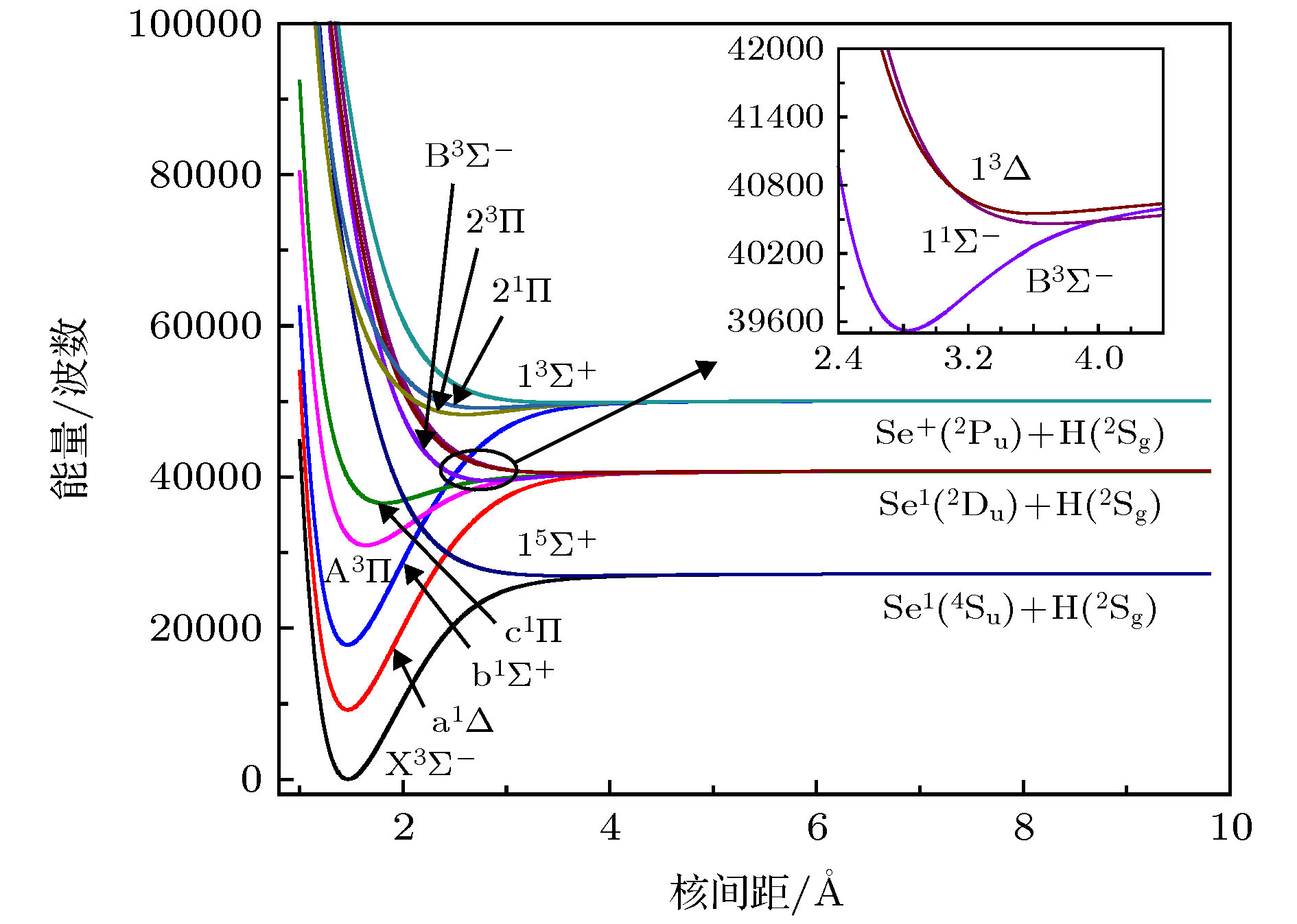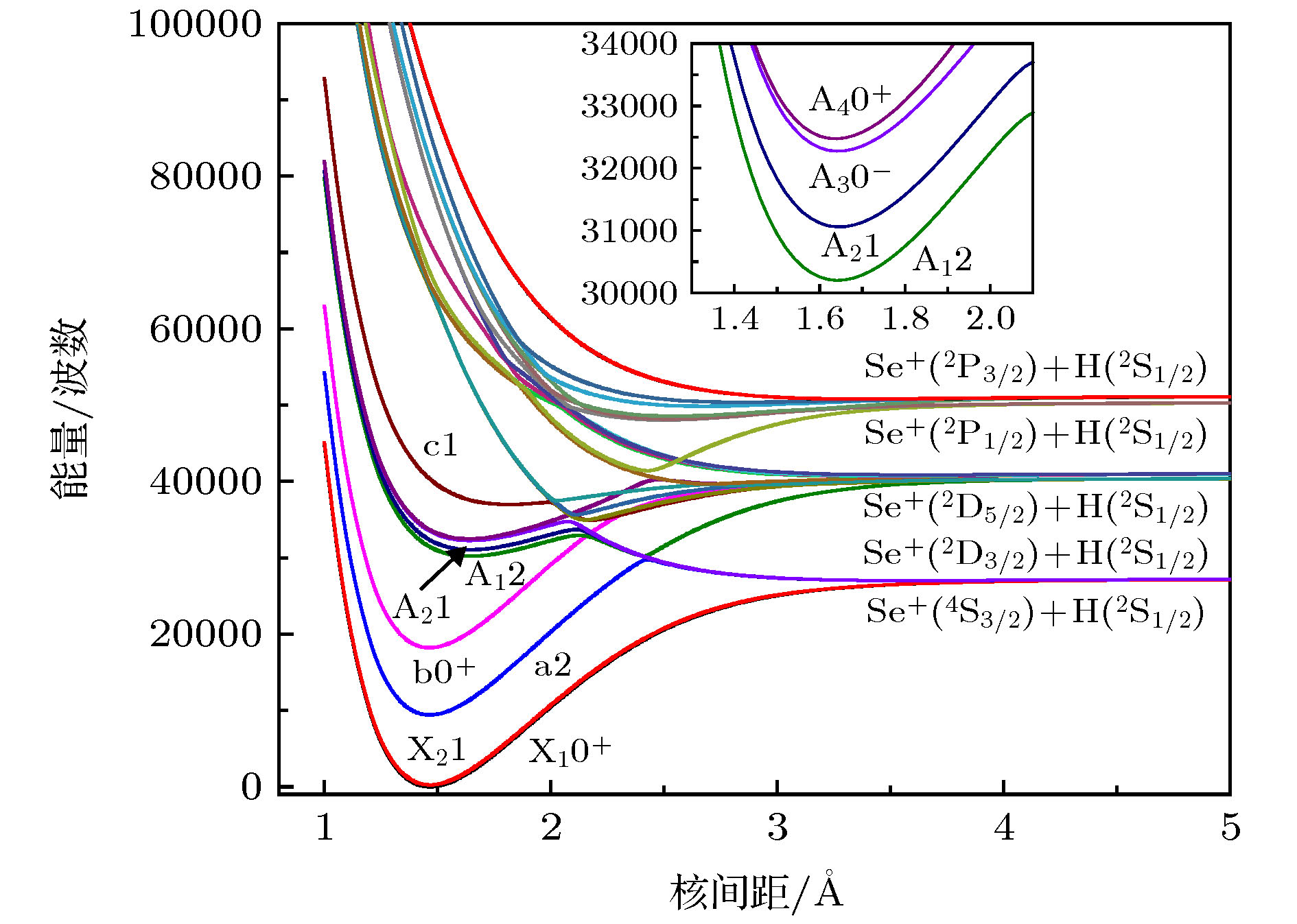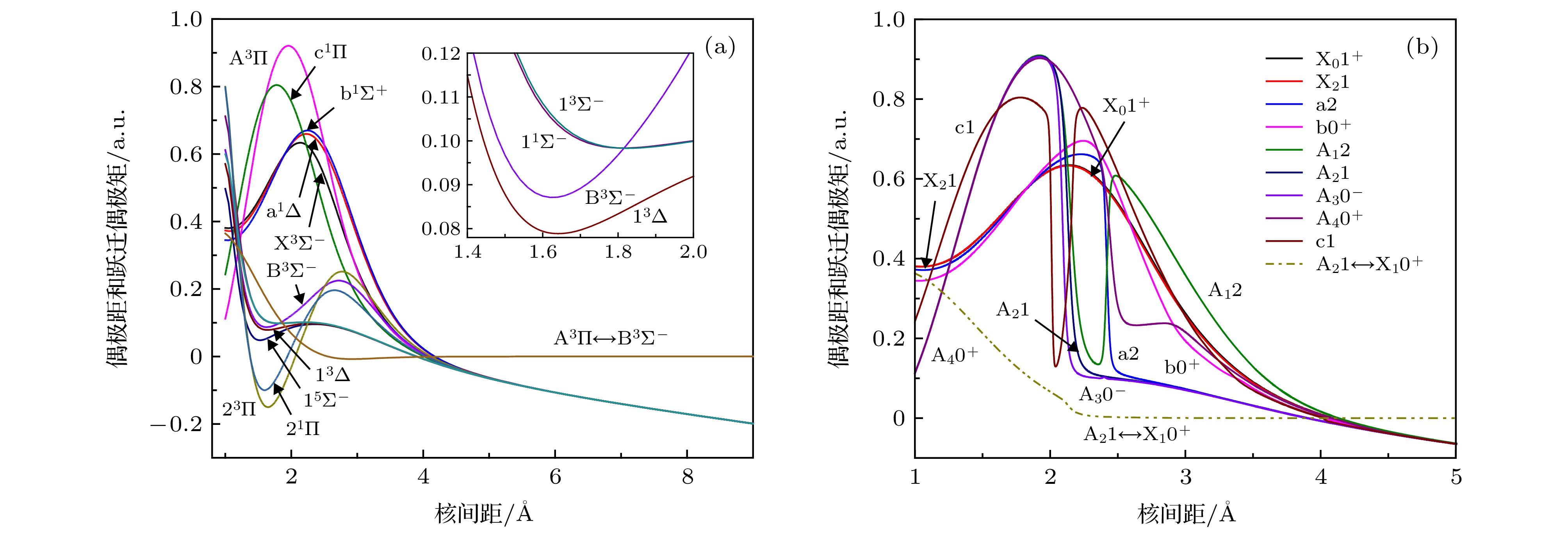-
采用内收敛多组态相互作用及Davidson修正方法精确地计算了SeH+离子能量最低的3个离解极限对应的12个Λ—S态的势能曲线. 计算中考虑了芯-价电子关联、标量相对论修正和自旋-轨道耦合效应. 结果表明在30000—40000 cm–1处Ω态的曲线存在许多避免交叉, 导致a2, b0+, A12, A21, A30–, A40+和c1态变为了双势阱. 通过求解径向薛定谔方程得到了12个Λ—S态和9个Ω态的光谱常数. 基于势能曲线和跃迁偶极矩, 预测出了
$ {{\rm{A}}^3}\Pi \leftrightarrow {{\rm{X}}^3}{\Sigma ^ - }$ 和$ {{\rm{A}}_2}1 \leftrightarrow {{\rm{X}}_1}{0^ + }$ 跃迁的弗兰克-康登因子、辐射速率和辐射寿命. 首次系统地报道了SeH+离子的光谱与跃迁性质.Potential energy curves of dipole moments for 12 electronic states correlating with the Se+(4Su) + H(2Sg), Se+(2Du) + H(2Sg) and Se+(2Pu) + H(2Sg) dissociation channels of SeH+ anion are calculated by the ic-MRCI + Q method. The AV5Z-DK basis set for Se atom and H atom are chosen. Scalar relativistic effect, core-valence correction, and spin-orbit coupling effect are also taken into account. In MRCI calculations, Se(1s2s) orbitals are frozen, H(1s) and Se(4s4p) orbitals are selected as active space, and the remaining orbitals are used for the core-valence correlation. Spectroscopic parameters of 12 Λ–S states and 9 low-lying Ω states are obtained. All Λ–S states we selected are bound states. The X3Σ–, a1Δ, b1Σ+, A3Π and c1Π states each possess a large well, but the others each have a shallow well. The a1Δ, b1Σ+, A3Π, c1Π and 15Σ– states cross in 30000–40000 cm–1 regions. The X3Σ–, a1Δ and b1Σ+ come from the 4π2 electronic configuration around the equilibrium region, and three states have similar values of Re. The splitting dissociation channels are obtained at a spin-orbital coupling level. The calculated energy differences among five dissociation channels are in excellent agreement with the experimental data, and the maximal error is smaller than 0.5%. Due to the avoided crossing between the low-lying Ω states, the a2, b0+, A12, A21, A30–, A40+ and c1 states all have two wells. The splitting parameters ASO of the X3Σ– state and the A3Π state are predicted at the same time, i. e. ASO(X21 – X10+) = 252.4 cm–1, ASO(A21 – A12) = 858.9 cm–1, ASO(A30– – A21) = 1213.5 cm–1 and ASO(A40+ – A30–) = 199.5 cm–1. The transition dipole moments of the A3Π $ \leftrightarrow $ X3Σ– and A21$ \leftrightarrow $ X10+ transitions are obtained. The oscillator strengths, Franck-Condon factors, and radiative lifetimes of these two transitions are also predicted. The radiative lifetime of A3Π state and A21 state are 746.6 and 787.8 ns, respectively. It implies the ability of electron transition for these two transitions.-
Keywords:
- multi-reference configuration interaction /
- spin-orbit coupling effect /
- spectroscopic constants /
- spontaneous radiative lifetimes
[1] Ram R S, Bernath P F 2000 J. Mol. Spectrosc. 203 9
 Google Scholar
Google Scholar
[2] Lindgren B 1968 J. Mol. Spectrosc. 28 536
 Google Scholar
Google Scholar
[3] Davies P B, Handy B J, Lloyd E K M, Russell D K 1978 J. Chem. Phys. 68 3377
 Google Scholar
Google Scholar
[4] Brown J M, Carrington A, Sears T J 1979 Mol. Phys. 37 1837
 Google Scholar
Google Scholar
[5] Cliff D I, Davies P B, Handy J J, Thrush B A 1980 Chem. Phys. Lett. 75 9
 Google Scholar
Google Scholar
[6] Bollmark, Lindgren B, Sassenberg U 1980 Phys. Scr. 21 811
 Google Scholar
Google Scholar
[7] Brown J M, Fackerell A D 1982 Phys. Scr. 25 351
 Google Scholar
Google Scholar
[8] Ashworth S H, Brown J M 1991 Chem. Phys. Lett. 182 73
 Google Scholar
Google Scholar
[9] Balasubramanian K, Liao M Z, Han M 1987 Chem. Phys. Lett. 139 551
 Google Scholar
Google Scholar
[10] Moore C E 1971 Atomic Energy Levels (Vol. 1) (Washington, DC: National Bureau of Standards Publications) pp2, 153
[11] Binning J R C, Curtiss L A 1990 J. Chem. Phys. 92 3688
 Google Scholar
Google Scholar
[12] Guberman S L 1995 J. Chem. Phys. 102 1699
 Google Scholar
Google Scholar
[13] Khadri F, Ndome H, Lahmar S, Lakhdar Z B, Hochlaf M 2006 J. Mol. Spectrosc. 237 232
 Google Scholar
Google Scholar
[14] Santos L G dos, Oliveira A G S de, Ornellas F R 2015 J. Chem. Phys. 142 024316
 Google Scholar
Google Scholar
[15] Song Y Z, Zhang L L, Gao S B, Meng Q T 2016 Sci. Rep. 6 37734
 Google Scholar
Google Scholar
[16] Zhang L L, Gao S B, Meng Q T, Pan J, Song Y Z 2018 J. Chem. Phys. 149 154303
 Google Scholar
Google Scholar
[17] 施德恒, 刘慧, 孙金锋, 朱遵略, 刘玉芳 2010 物理学报 59 227
 Google Scholar
Google Scholar
Shi D H, Liu H, Sun J F, Zhu Z L, Liu Y F 2010 Acta Phys. Sin. 59 227
 Google Scholar
Google Scholar
[18] 赵书涛, 梁桂颖, 李瑞等 2017 物理学报 66 063103
 Google Scholar
Google Scholar
Zhao S T, Liang G Y, Li R, et al. 2017 Acta Phys. Sin. 66 063103
 Google Scholar
Google Scholar
[19] Werner H J, Knowles P J, Knizia G, et al. 2010 MOLPRO, a Package of ab initio Programs (version 2010)
[20] Knowles P J Werner H J 1985 J. Chem. Phys. 82 5053
 Google Scholar
Google Scholar
[21] Knowles P J Werner H J 1985 Chem. Phys. Lett. 115 259
 Google Scholar
Google Scholar
[22] Werner H J, Knowles P J 1988 J. Chem. Phys. 89 5803
 Google Scholar
Google Scholar
[23] Knowles P J Werner H J 1988 Chem. Phys. Lett. 145 514
 Google Scholar
Google Scholar
[24] Dunning T H Jr 1989 J. Chem. Phys. 90 1007
 Google Scholar
Google Scholar
[25] Wilson A K, Woon D E, Peterson K A, Dunning T H Jr 1999 J. Chem. Phys. 110 7667
 Google Scholar
Google Scholar
[26] Douglas M, Kroll N M 1974 Ann. Phys. 82 89
 Google Scholar
Google Scholar
[27] Hess B A 1986 Phys. Rev. A 33 3742
 Google Scholar
Google Scholar
[28] Berning A, Schweizer M, Werner H J, Knowles P J, Palmieri P 2000 Mol. Phys. 98 1823
 Google Scholar
Google Scholar
[29] Le Roy R J 2007 Level 8.0: A Computer Program for Solving the Radial Schrödinger Equation for Bound and Quasibound Levels (Waterloo: University of Waterloo) Chemical Physics Research Report CP-663
[30] Stollenwerk P R, Kokish M G, Antonio G. S. Oliveira-Filho de A G S, Ornellas F R, Odom B C 2018 Atoms 6 53
 Google Scholar
Google Scholar
[31] Kjaergaard H G, Yu H, Schattka B J, Henry B R, Tarr A W 1990 J. Chem. Phys. 93 6239
 Google Scholar
Google Scholar
-
表 1 SeH+离子Λ—S态的离解关系
Table 1. Dissociation relationships of Λ-S states of SeH+.
原子态 Λ–S态 相对能量/cm–1 本文工作a Se+(4Su) + H(2Sg) 3, 5Σ– 0 Se+(2Du) + H(2Sg) 1, 3Σ–, 1, 3Π, 1, 3Δ 13590.3 Se+(2Pu) + H(2Sg) 1, 3Σ+, 1, 3Π 22896.5 a同一离解极限对应的所有电子态的平均能量. 表 2 SeH+离子Λ—S态的光谱常数
Table 2. Spectroscopic constants of the Λ–S states of SeH+.
电子态 Re/Å ωe/cm–1 ωeχe/cm–1 Be/cm–1 De/eV Te/cm–1 X3Σ– 1.4659 2387.48 45.81 7.8816 3.369 0 1.474[11] a1Δ 1.4642 2393.52 40.79 7.8999 3.920 9179.3 b1Σ+ 1.4622 2406.68 40.39 7.9224 4.006 17761.9 15Σ– 3.5894 152.17 25.85 1.3340 0.030 26930.2 A3Π 1.6395 1505.52 57.16 6.2961 1.207 30953.8 c1Π 1.8168 989.95 59.14 5.1488 0.515 36530.2 B3Σ– 2.8262 490.08 47.96 2.1460 0.157 39522.1 11Σ– 3.6892 162.98 19.18 1.2109 0.042 40461.9 13Δ 3.5593 139.94 20.44 1.2964 0.030 40552.3 23Π 2.6009 603.15 50.66 2.5253 0.223 48259.6 21Π 2.7701 400.92 43.54 2.2291 0.116 49124.6 13Σ+ 3.6000 151.41 25.73 1.3258 0.029 49835.4 表 3 第Ⅵ主簇氢化物正离子低电子态的光谱常数
Table 3. Spectroscopic constants of the low-lying states for the Ⅵ hydride cations.
表 4 SeH+离子Ω 态的离解关系
Table 4. Dissociation relationships of Ω states of SeH+.
原子态 Ω态 相对能量/cm–1 本文工作 文献[9]a 实验值[10] Se+(4S3/2) + H(2S1/2) 2, 1, 1, 0+, 0– 0 0 0 Se+(2D3/2) + H(2S1/2) 2, 1, 1, 0+, 0– 13189.0 17745 13168.2 Se+(2D5/2) + H(2S1/2) 3, 2, 2, 1, 1, 0+, 0– 13806.5 18347 13784.4 Se+(2P1/2) + H(2S1/2) 1, 0+, 0– 23115.9 23038.3 Se+(2P3/2) + H(2S1/2) 2, 1, 1, 0+, 0– 23928.7 23894.8 a根据文献[9]的计算数据推导得到. 表 5 SeH+离子Ω态的光谱常数
Table 5. Spectroscopic constants of the Ω states of SeH+.
电子态 Re /Å ωe /cm–1 ωeχe /cm–1 Be /cm–1 De /eV Te /cm–1 X10+ 1.4661 2385.56 45.66 7.8802 3.380 0 X21 1.4662 2386.15 46.02 7.8790 3.348 252.4 a2 第一势阱 1.4645 2392.76 41.29 7.8967 2.525 9408.2 第二势阱 3.5800 168.60 33.67 1.3399 0.030 27016.9 b0+ 1.4631 2406.94 44.20 7.9127 2.758 18213.8 A12 第一势阱 1.6418 1396.10 53.29 6.3333 0.340 30201.1 第二势阱 2.4132 2295.44 131.22 2.9938 1.262 30248.9 A21 第一势阱 1.6457 1381.37 53.81 6.3229 0.329 31060.0 第二势阱 3.5900 152.22 25.81 1.3353 0.030 27018.9 A30– 第一势阱 1.6429 1391.28 55.78 6.3715 0.307 32273.5 第二势阱 3.6000 151.93 25.77 1.3339 0.030 27019.3 A40+ 第一势阱 1.6368 1385.24 18.09 6.3123 0.962 32473.0 第二势阱 2.7918 676.20 90.61 2.1897 0.167 39685.4 c1 第一势阱 1.8161 — — — 0.044 36979.9 第二势阱 2.1793 1781.89 149.33 3.5614 0.687 34921.9 表 6
$ {{\rm{A}}^3}\Pi \leftrightarrow {{\rm{X}}^3}{\Sigma ^ - }$ 和$ {{\rm{A}}_2}1 \leftrightarrow {{\rm{X}}_1}{0^ + }$ 跃迁的弗兰克-康登因子(单位s-1)、总辐射速率和辐射寿命(单位: ns)Table 6. Franck-Condon Factors, Emission rates (unit of s–1) and radiative lifetimes τ (unit of ns) of the
$ {{\rm{A}}^3}\Pi \leftrightarrow {{\rm{X}}^3}{\Sigma ^ - }$ and$ {{\rm{A}}_2}1 \leftrightarrow {{\rm{X}}_1}{0^ + }$ transitions.跃迁 ν' ν'' = 0 ν'' = 1 ν'' = 2 ν'' = 3 ν'' = 4 ν'' = 5 ΣA τ = 1/(ΣA) $ {\rm A^3}\Pi \leftrightarrow {\rm X^3}{\Sigma ^ - }$ 0 0.4079 0.3685 0.1666 0.0470 0.0088 0.0011 1339434 746.6 1 0.3271 0.0013 0.2122 0.2713 0.1398 0.0405 1310290 763.2 $ {\rm A_2}1 \leftrightarrow {\rm X_1}{0^ + }$ 0 0.3841 0.3688 0.1787 0.0549 0.0116 0.0017 1269392 787.8 1 0.3186 0.0001 0.1761 0.2695 0.1629 0.0558 1212188 825.0 -
[1] Ram R S, Bernath P F 2000 J. Mol. Spectrosc. 203 9
 Google Scholar
Google Scholar
[2] Lindgren B 1968 J. Mol. Spectrosc. 28 536
 Google Scholar
Google Scholar
[3] Davies P B, Handy B J, Lloyd E K M, Russell D K 1978 J. Chem. Phys. 68 3377
 Google Scholar
Google Scholar
[4] Brown J M, Carrington A, Sears T J 1979 Mol. Phys. 37 1837
 Google Scholar
Google Scholar
[5] Cliff D I, Davies P B, Handy J J, Thrush B A 1980 Chem. Phys. Lett. 75 9
 Google Scholar
Google Scholar
[6] Bollmark, Lindgren B, Sassenberg U 1980 Phys. Scr. 21 811
 Google Scholar
Google Scholar
[7] Brown J M, Fackerell A D 1982 Phys. Scr. 25 351
 Google Scholar
Google Scholar
[8] Ashworth S H, Brown J M 1991 Chem. Phys. Lett. 182 73
 Google Scholar
Google Scholar
[9] Balasubramanian K, Liao M Z, Han M 1987 Chem. Phys. Lett. 139 551
 Google Scholar
Google Scholar
[10] Moore C E 1971 Atomic Energy Levels (Vol. 1) (Washington, DC: National Bureau of Standards Publications) pp2, 153
[11] Binning J R C, Curtiss L A 1990 J. Chem. Phys. 92 3688
 Google Scholar
Google Scholar
[12] Guberman S L 1995 J. Chem. Phys. 102 1699
 Google Scholar
Google Scholar
[13] Khadri F, Ndome H, Lahmar S, Lakhdar Z B, Hochlaf M 2006 J. Mol. Spectrosc. 237 232
 Google Scholar
Google Scholar
[14] Santos L G dos, Oliveira A G S de, Ornellas F R 2015 J. Chem. Phys. 142 024316
 Google Scholar
Google Scholar
[15] Song Y Z, Zhang L L, Gao S B, Meng Q T 2016 Sci. Rep. 6 37734
 Google Scholar
Google Scholar
[16] Zhang L L, Gao S B, Meng Q T, Pan J, Song Y Z 2018 J. Chem. Phys. 149 154303
 Google Scholar
Google Scholar
[17] 施德恒, 刘慧, 孙金锋, 朱遵略, 刘玉芳 2010 物理学报 59 227
 Google Scholar
Google Scholar
Shi D H, Liu H, Sun J F, Zhu Z L, Liu Y F 2010 Acta Phys. Sin. 59 227
 Google Scholar
Google Scholar
[18] 赵书涛, 梁桂颖, 李瑞等 2017 物理学报 66 063103
 Google Scholar
Google Scholar
Zhao S T, Liang G Y, Li R, et al. 2017 Acta Phys. Sin. 66 063103
 Google Scholar
Google Scholar
[19] Werner H J, Knowles P J, Knizia G, et al. 2010 MOLPRO, a Package of ab initio Programs (version 2010)
[20] Knowles P J Werner H J 1985 J. Chem. Phys. 82 5053
 Google Scholar
Google Scholar
[21] Knowles P J Werner H J 1985 Chem. Phys. Lett. 115 259
 Google Scholar
Google Scholar
[22] Werner H J, Knowles P J 1988 J. Chem. Phys. 89 5803
 Google Scholar
Google Scholar
[23] Knowles P J Werner H J 1988 Chem. Phys. Lett. 145 514
 Google Scholar
Google Scholar
[24] Dunning T H Jr 1989 J. Chem. Phys. 90 1007
 Google Scholar
Google Scholar
[25] Wilson A K, Woon D E, Peterson K A, Dunning T H Jr 1999 J. Chem. Phys. 110 7667
 Google Scholar
Google Scholar
[26] Douglas M, Kroll N M 1974 Ann. Phys. 82 89
 Google Scholar
Google Scholar
[27] Hess B A 1986 Phys. Rev. A 33 3742
 Google Scholar
Google Scholar
[28] Berning A, Schweizer M, Werner H J, Knowles P J, Palmieri P 2000 Mol. Phys. 98 1823
 Google Scholar
Google Scholar
[29] Le Roy R J 2007 Level 8.0: A Computer Program for Solving the Radial Schrödinger Equation for Bound and Quasibound Levels (Waterloo: University of Waterloo) Chemical Physics Research Report CP-663
[30] Stollenwerk P R, Kokish M G, Antonio G. S. Oliveira-Filho de A G S, Ornellas F R, Odom B C 2018 Atoms 6 53
 Google Scholar
Google Scholar
[31] Kjaergaard H G, Yu H, Schattka B J, Henry B R, Tarr A W 1990 J. Chem. Phys. 93 6239
 Google Scholar
Google Scholar
计量
- 文章访问数: 9848
- PDF下载量: 90
- 被引次数: 0

















 下载:
下载:






